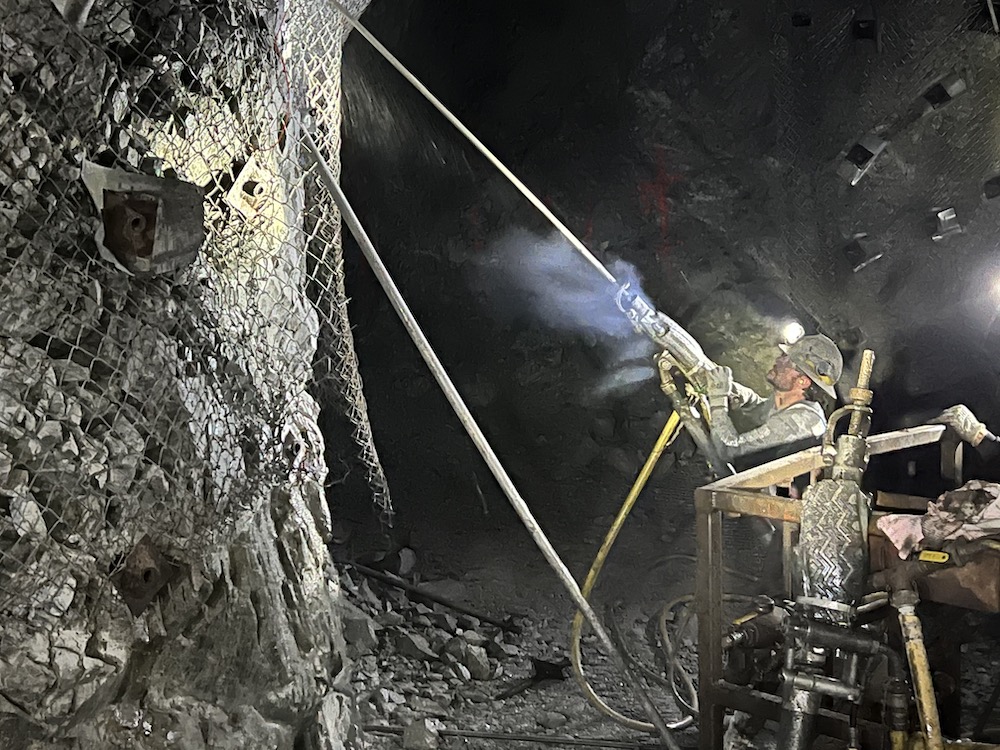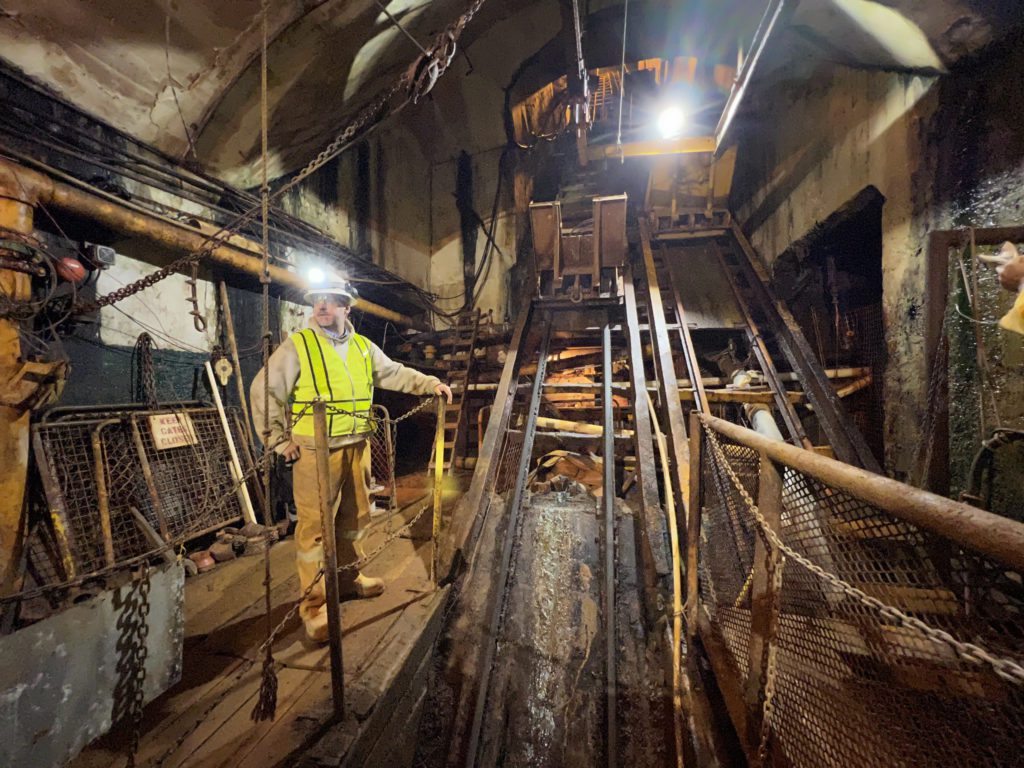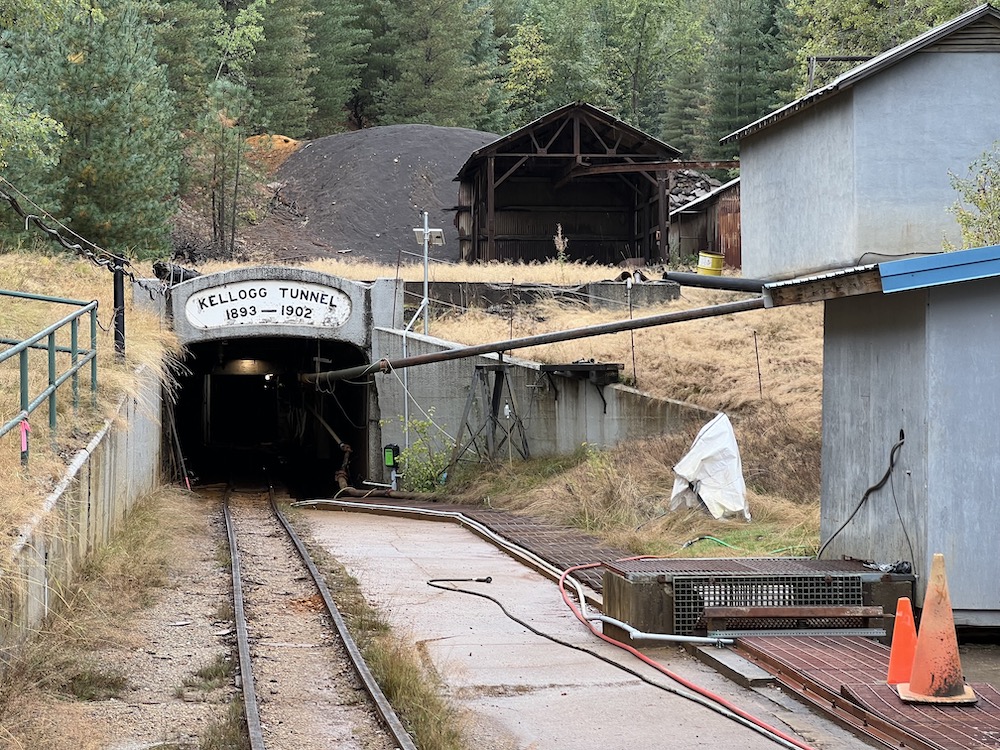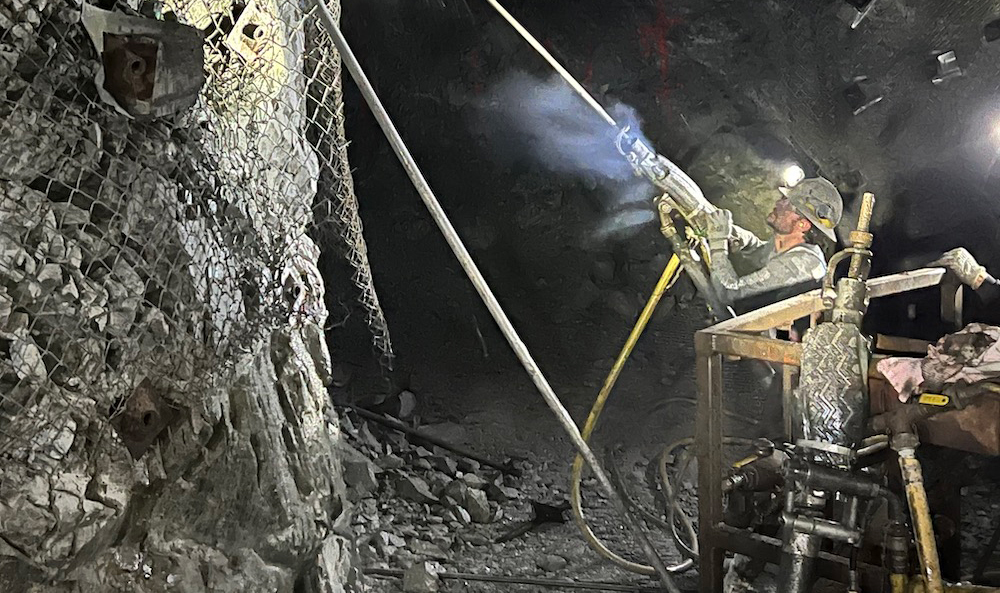
The legacy Bunker Hill zinc-lead-silver mine in Shoshone County, Idaho, is set for a near-term revival with proponent Bunker Hill Mining (CSE: BNKR; US-OTC: BHLL) on track to deliver cash flow by the third quarter of 2023.
The Toronto-headquartered company plans to restart operations at the mine in short order after the asset languished on care and maintenance for more than 30 years. Over nearly a century, it has produced more than 165 million oz. of silver and 5 million tons of base metals.
“Many project proponents are watching our progress closely since the Bunker Hill restart would prove to the market that stranded brownfields sites such as Bunker Hill with legacy environmental challenges can indeed be funded for redevelopment and production,” said executive chair and former Barrick executive Richard Williams during a tour of the site in late September.
The Northern Miner witnessed underground development and rehabilitation of the old equipment in progress on the outskirts of the twin cities of Kellogg and Wardner during the visit. The key takeaway from the visit is that the historical asset is in the right hands at the right time, considering the experienced team driving the restart amid compelling fundamentals for the metals it will produce.
Bunker Hill Mining published a prefeasibility study for the mine early in September, outlining a rapid restart for a total investment of $54.8 million, which includes continency.
It covers the first phase of the restart, with an estimated life of mine (LOM) of five years.
A second-phase expansion is expected to provide upside potential from resource conversion, metallurgical optimization, and mine life extension.
According to the prefeasibility, the project is expected to generate a pre-tax free cash flow of $137 million over the initial mine plan (average of $27 million per year) and $130 million on an after-tax basis (average of $26 million per year).
The study delivered an NPV (8% discount) of $52 million and an IRR of 36%, both figures on an after-tax basis.

So firm is management’s conviction of the mineralization in place, it has decided to go ahead with production without completing a bankable feasibility study.
Probable reserves at Bunker Hill are estimated at 3.2 million short tonnes (2.9 million tonnes), grading 5.3% zinc, 2.4% lead and 1.02 oz. silver per tonne.
Development of the Bunker Hill property dates back to 1885, with the mine closing in 1981 due to low base metal prices. The decision to suspend mining was also forced by financial reasons as the new environmental regulations at that time required significant capital investment to upgrade the processing and smelting operations.
The mine was reopened in 1988 and operated until 1991. Since then, it has been under care and maintenance.
The mine produced 42.8 million tons at an average grade of 8.43% lead, 3.52 oz. silver per ton, and 4.52% zinc.

The lead smelter and zinc processing plants were dismantled following the final closure.
The federal government had to step in to remedy acid water discharge from the mine, requiring significant investment to set up a state-run water treatment facility near the mine site. Site clean-up activities were also completed to comply with environmental regulations under the auspices of the U.S. Environmental Protection Agency’s so-called Superfund program.
More recently, Bunker Hill Mining signed an agreement with Placer Mining and two individuals, William Pangburn and Shirley Pangburn, to purchase the mine property, including the mineral titles and surface rights in December 2021, as well as committing to pony up environmental bonding payment of US$17 million due by November 2024. The company assumed ownership of the property in January 2022.
Meanwhile, Bunker Hill Mining signed an agreement with Teck Resources (TSX: TCK.A/TCK.B; NYSE: TCK) to buy the Pend Oreille process plant in January 2022 and completed the transaction in June. The mill was dismantled from Teck’s Pend Oreille site and demobilized to the Bunker Hill site in August 2022.
However, the company recently announced that it had secured a larger ball mill with 2,100 tons per day capacity. That is enough for the first phase’s envisaged 1,800 tons per day throughput, with expansion upside built in.
“Subject to future detailed engineering and mine planning, the mill could also support a throughput increase to 2,100 tons per day. Given the potentially very long life of the Bunker Hill mine, this optionality represents an obvious source of value creation,” said CEO Sam Ash.
Ash explained that the new ball mill would replace the three other mills procured from the Pend Oreille site. “We look forward to finalizing the purchase and integrating it into our mill construction plans.”
In preparation for the redevelopment work, Bunker Hill executed a non-binding term sheet with Sprott Private Resource Streaming and Royalty (SRSR) for a $50 million project finance package in December 2021. The package is being used to fund the mine restart.
Teck also holds an exclusive option to acquire all the zinc and lead concentrate produced from the Bunker Hill mine for five years.
“We have a low-cost producer of metals here in a top-tier jurisdiction which ranked first in the Fraser Institute’s 2020 survey, and in the most prolific global silver region in the Silver Valley,” Williams said.
“We have no permitting constraints since the asset is on patented claims and private ground, enabling us to work towards a rapid restart to generate free cash flow to fund further growth in the near term.”
In Williams’ view, the critical risk to the company’s success lies in execution. However, he can see a potential future where the cash-flowing company pivots to becoming a growth company. “When the mine starts producing free cash flow, we can see a clear path to value creation through strategic mergers and acquisitions opportunities in the zinc-silver space and apply the turnaround strategy to other stranded assets,” he said.

The Bunker Hill management team is confident they can conduct business in a low-cost, sustainable way, capitalizing on historically higher metal prices and significant infrastructure in place, including the ongoing treatment of acid wastewater streams.
According to the prefeasibility study, the Newgard and Quill zones will be mined first using the underground mining method of long-hole open stoping with backfill. Stopes are proposed to be accessed through lateral shafts from the Newgard ramp.
The Northern Miner witnessed new excavations underway to provide primary access to the new stoping areas and connect to some of the existing lower levels, which are to be dewatered over time and rehabilitated.
A hydraulic backfill plant and distribution system will provide the backfill for the operations.
The process flow sheet calls for run-of-mine ore to be transferred to a mobile jaw crusher at the surface portal in Wardner and trucked to the secondary crushing circuit after the crushing process using a haul road bypassing the two cities.
The central processing facility and secondary crusher will be in the Kellogg yard, which lies adjacent to the Kellogg adit. A new concentrator facility will also be built at the existing Bunker Hill maintenance building site. There are also negotiations underway to use other existing infrastructure such as a truck wash before loaded trucks head out on the open road to deliver their concentrates to Teck’s Trail smelter in B.C.
The new concentrator facility will house a primary ball milling circuit that feeds a conventional differential flotation circuit for lead and zinc. The north end of the concentrator site will be used for concentrate dewatering and loadout to support the loading of concentrate trucks. Concentrator tailings will be filtered to produce a tailings filter cake, explained Ash.
The Bunker Hill mine has much of the underground infrastructure and development still in place, with a few facilities requiring refurbishment.
The Kellogg Tunnel opened in 1893 and is immediately next to the mine offices. It is currently used for rail haulage and connecting to the main hoist rooms and incline shafts. There are two existing shafts providing access to the lower levels of the mine.
Avista Utilities provide power supply for the mine operations via a substation near the Kellogg-side office complex. Management had indicated that the site has enough power for the initial restart of operations, with plans to upgrade the substation to support the power requirements of the entire mine by the third year of operation.
The company will tap into underground water sources for the mine and process distribution. The freshwater needs of the concentrator are expected to be met from mine water sources or a water treatment facility within the concentrator plant.
An on-site pilot water treatment plant became operational in May. It is designed to treat the effluent before the final treatment by the government-owned water treatment plant, with management indicating satisfactory performance. A long-term, on-site pilot water treatment plant is planned at the mine.
As for the continued exploration potential at Bunker Hill, Ash is optimistic. He said most of the significant Silver Valley mines, including Sunshine, Galena, Star-Morning and Lucky Friday, have produced, in total, hundreds of millions of ounces of silver at depths well exceeding the maximum developed depth of the Bunker Hill mine. He emphasises that there is excellent exploration potential for high-grade silver mineralization below the 4,000-feet level, representing one of the shallowest underground mine bottom levels in the Silver Valley.
The property is within the Coeur d’Alene silver district in the Northern Idaho Panhandle region, which is underlain by sedimentary rocks of the middle Proterozoic-aged Belt-Purcell Supergroup, technical services lead Kyle Ermann told the tour delegates.
He explained the mineralization at the Bunker Hill mine occurs as mineralized shoots hosted in quartzite units intersected by vein structures.
Williams says the company would seek to upgrade its CSE listing to the higher-tier TSX Venture exchange. “Our market cap is not even 1x our expected cash flow next year,” he said.